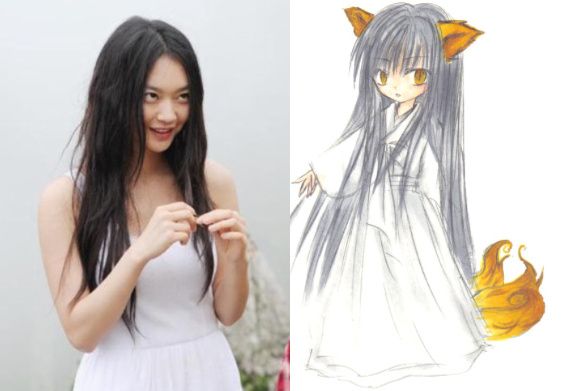
In honor of My Girlfriend is a Gumiho premiering this week, we thought it would be a good time to define what a gumiho is, and discuss this mythical creature’s cultural implications on gender, film, and tv. This isn’t a comprehensive definition, by any means, because there are endless number of myths, folktales, films, and dramas that feature gumihos in them. But I’ll cover the basics and discuss what’s interesting about this figure from a cultural point of view.
A gumiho [구미호] is a nine-tailed fox, a legendary creature with origins in ancient Chinese myths dating back centuries. There are versions of the figure in Chinese and Japanese folklore, although each differs slightly. The Chinese huli jing and the Japanese kitsune have more ambiguous moral compasses, in that they can be both good and bad, and are not necessarily out to get everyone. The Korean gumiho, on the other hand, is almost always a malignant figure, a carnivore who feasts on human flesh.

According to legend, a fox that lives a thousand years turns into a gumiho, a shape-shifter who can appear in the guise of a woman. A gumiho is evil by nature, and feeds on either human hearts or livers (different legends specify one or the other) in order to survive. The Chinese huli jing is said to be made up of feminine energy (yin) and needs to consume male energy (yang) to survive. The Japanese kitsune can be either male or female, and can choose to be quite benevolent.
The Korean gumiho is traditionally female. Some can hide their gumiho features, while other myths indicate that they can’t fully transform (ie. a fox-like face or set of ears, or the tell-tale nine tails). Either way there is usually at least one physical trait that will prove their true gumiho form, or a magical way to force them to reveal this form.
Much like werewolves or vampires in Western lore, there are always variations on the myth depending on the liberties that each story takes with the legend. Some tales say that if a gumiho abstains from killing and eating humans for a thousand days, it can become human. Others, like the drama Gumiho: Tale of the Fox’s Child, say that a gumiho can become human if the man who sees her true nature keeps it a secret for ten years. Regardless of each story’s own rules, a few things are always consistent: a gumiho is always a fox, a woman, a shape-shifter, and a carnivore.

Now on to the cultural meanings. A fox is a common figure in many different cultures that represents a trickster or a smart but wicked creature that steals or outwits others into getting what it wants. Anyone who grew up on Aesop’s Fables knows the classic iteration of the fox figure in folklore. And it’s not hard to see how the fox got such a bad rap. The animal is a nocturnal hunter and a thief by nature, and is known the world over for its cunning mind.
In Korea, the fox has a second cultural implication—that of sexual cunning. The word for fox, yeo-woo [여우] is actually what Koreans call a woman who is, for lack of a better translation, a vixen, a siren, or a sly man-eater. There is a similar English equivalent in the phrase “you sly fox,” although in Korean it’s gender-specific (only women get called yeo-woo), and has a much more predatory “there-you-go-using-your-feminine-wiles-to-trick-me” kind of meaning behind it. Women who use any sort of feminine charm in an overt way, or women who are overtly sexualized (as in, asserting and brandishing their sexuality in a bold way), get called “yeo-woo.” Interestingly, the word for “actress” [여배우] is the same in its shortened form: [여우].


It is not by mistake that gumihos are only beautiful women. They are a folkloric way to warn men of the pitfalls of letting a woman trick you or seduce you into folly. For an example, see this translation of a classic gumiho tale. In many stories the hero of the tale (always a man) has to “endure” the seduction and unclothe the gumiho, thereby revealing her true form. Thus a woman’s true nature, her hidden sexuality = demon.
WTF, Korean folktales?
The concept of female sexuality as dangerous is nothing new to folklore, for sure. But it’s not a stretch to say that both the gumiho figure and the use of “yeo-woo” are quite prevalent in modern culture and its fiction. Most people may gloss over the fact that the gumiho myth is a story designed to uphold patriarchy. But that’s what makes such a legend so cunning in its own right.


In film and tv, the gumiho can be both a horrific figure and a straight-up demon, or a comically laughable one, depending on the genre. And throughout the ages the gumiho legend has changed, as in Gumiho: Tale of the Fox’s Child ‘s take on the tortured gumiho with a kind soul who longs to be human and spares men’s lives. She is a reluctant demon who chooses to walk the fine line of morality in order to hold onto her human traits. This interpretation is much closer to the vampire-with-a-soul mythology, as one being battles the demon within.

But one interesting thing to note in that drama is that the child, once she comes of age, transforms into a gumiho herself and struggles with that overpowering demonic force. One can’t help but draw parallels to a young girl’s own coming of age and sexual development, and how this myth only serves to further demonize a woman’s sexuality as something uncontrollable and evil that befalls even the most innocent of young girls. In this, and other more overtly sexualized depictions, the gumiho serves to downgrade female sexuality as demonic and directly carnivorous of men.
All this isn’t to say that female writers couldn’t take ownership of such a legend and reclaim it. I think that’s the only way to take it out of this territory and blast all these old versions away with something empowered. Do I think that’s what the Hong sisters’ goal is? Not outright. And I’m definitely not going to be watching that rom-com for its stellar commentary on gender politics. What I will be doing is looking forward to the reversal, the woman-on-top dynamic of the beta male dating a powerful gumiho, and crossing my fingers for a step in the right direction.

credit : girlfriday@DB+As labeled


No comments:
Post a Comment